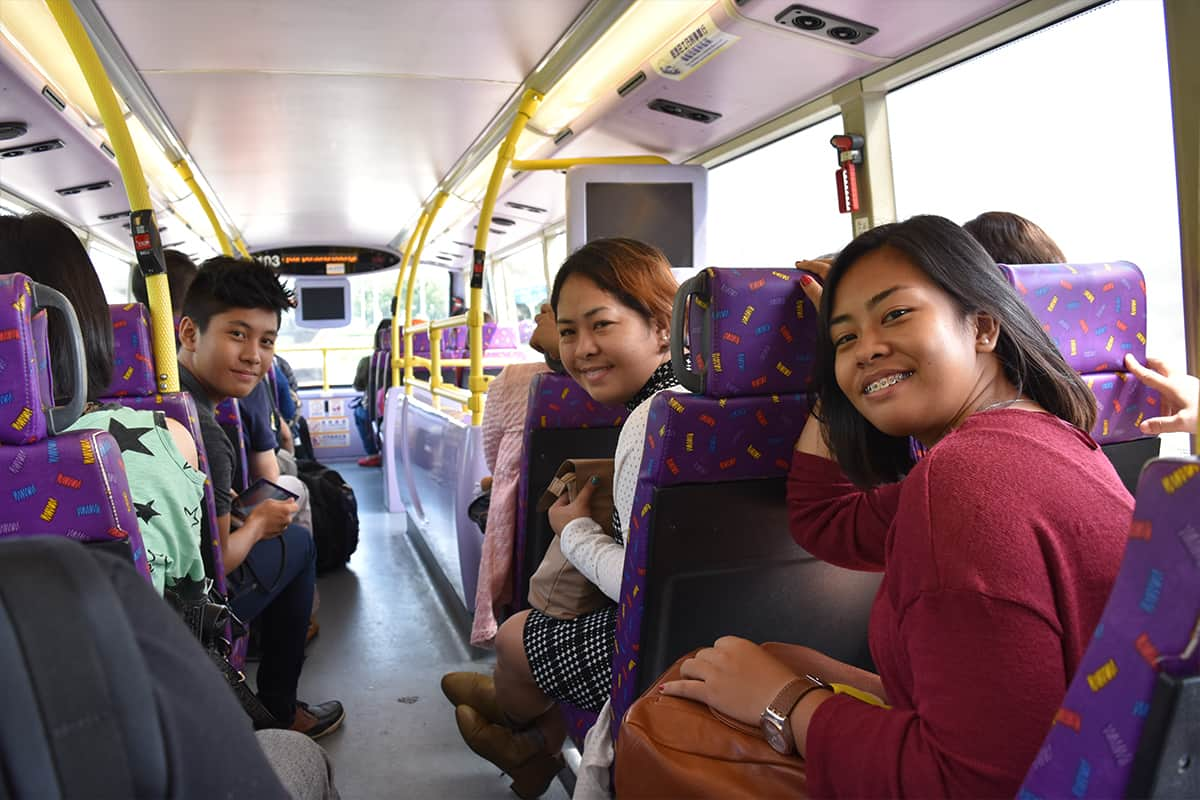Commuting in Hong Kong is easy. You can choose from taxi, bus, subway train, tram or ferry. The most convenient of course is taxi if you have extra money to spend. But if you are like us who’s traveling with a tight budget, most likely riding taxi is not an option.
Commuting in Hong Kong: Bus
We took the bus (A21) from Hong Kong International Airport to Tsim Sha Tsui. This is a double decker bus. You can leave your luggage below and stay in top deck to enjoy the view. Don’t worry about your luggage. There are monitor in front of you where you can watch your luggage.
Hong Kong buses with more than 700 routes have covered almost all the region except some outlying islands. They are very important means of transportation in the Ocean Park, Repulse Bay and Lord Stanley in the south of Hong Kong Island. Almost all the buses running on Hong Kong Island are equipped with air-conditioning. Hong Kong boasts many double-decker buses, where passengers can sit near the front on the top deck, catch all the excitement and feel the pulse of city life. Also, there are night buses scheduled to operate at 0:00 – 6:00 which are good choice for the people arriving at the airport at night. All the night buses numbers start with letter “N”. (Source: Travelchinaguide)
Commuting in Hong Kong: MTR
My favorite ride is the MTR subway train. You just need to know where to transfer and use the correct train lane and you will not get lost in Hong Kong. We use MTR subway most of our trip. Just avoid the Airport Express MTR. The ride cost us a lot when we were stranded at Ngong Ping and almost missed our flight back to Manila.
The Mass Transit Railway (MTR) is a major public transport network serving Hong Kong. Operated by the MTR Corporation Limited (MTRCL), it consists of heavy rail, light rail, and feeder bus service centered on an 11-line rapid transit network serving the urbanized areas of Hong Kong Island, Kowloon, and the New Territories. The system included 230.9 km (143.5 mi) of rail in 2018 with 163 stations, including 95 heavy rail stations and 68 light rail stops. The MTR is one of the most profitable metro systems in the world; it had a farebox recovery ratio of 187 per cent in 2015, the world’s highest.
Under the government’s rail-led transport policy, the MTR system is a common mode of public transport in Hong Kong, with over five million trips made in an average weekday. It consistently achieves a 99.9 per cent on-time rate on its train journeys. As of 2018, the MTR has a 49.3 per cent market share of the franchised public transport market, making it the most popular transport option in Hong Kong. The integration of the Octopus smart card fare-payment technology into the MTR system in September 1997 has further enhanced the ease of commuting on the MTR.
Construction of the MTR was prompted by a study, released in 1967, commissioned by the Government of British Hong Kong in order to find solutions to the increasing road congestion problem caused by the territory’s fast-growing economy. Construction started soon after the release of the study, and the first line opened in 1979. The MTR was immediately popular with residents of Hong Kong; as a result, subsequent lines have been built to cover more territory. There are continual debates regarding how and where to expand the MTR network. (Source: Wikipedia)
Commuting in Hong Kong: Ferry
If you’re going to Hong Kong Island, try the ferry. Cheap and the view is amazing. The best time to ride the ferry is at night. Since our guest house is located at Tsim Sha Tsui, and the pier is nearby; we used Ferry to go places.
Hong Kong Ferry is an important transportation to connect Hong Kong Island and Kowloon which are separated by Victoria Harbour. It is also a main way for people to travel between the island and the outlying islands. The destinations of ferry in Hong Kong include 24 harbours in Macau and Mainland China. The major Hong Kong ferry companies are Star Ferry and New World First Ferry.
Hong Kong boasts many piers and can be grouped into, firstly, HK-Macau Ferry Terminal, Hong Kong International Airport SkyPier, China Ferry Terminal and secondly, the Tuen Mun Pier, Central Piers, Wan Chai Ferry Pier and North Point Ferry Pier etc. Whilst the first group provides transportation to mainland China or Macau, the second group provides routes between HK Island and Tsim Sha Tsui, Hung Hom or some outlying islands, such as Lamma Island, Peng Chau Island and Cheung Chau Island. (Source: Travelchinaguide)
Commuting in Hong Kong: Tramways
This reminds me of a caterpillar carnival ride. We scheduled a night side trip using the Tramways. We rode the the Tram from end to end terminals. We travelled from West all the way to the East of Hong Kong island. My wife hate it because of the slow moving and bumpy ride. The ride last close to two hours. When we disembarked, we all feel exhausted. We have our seats on the upper deck to have better view of the City. No air-conditioning but still the long ride is worth it.
The Hongkong Tramway Electric Company Limited was established in England, responsible for building and operating the tramway system for Hong Kong.
At the end of the same year, the Electric Traction Company of Hongkong Limited was founded and took control of the Hongkong Tramway Electric Company Limited. In 1910, the name of the Electric Traction Company was changed to Hong Kong Tramways Company Limited. (Source: Hong Kong Tramways)





